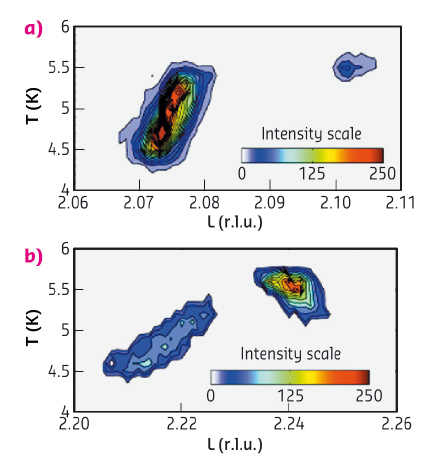- Home
- Users & Science
- Scientific Documentation
- ESRF Highlights
- ESRF Highlights 2015
- Electronic structure, magnetism and dynamics
- Complex modulated magnetism in PrPtAl
Complex modulated magnetism in PrPtAl
The discovery and characterisation of complex modulated magnetism in PrPtAl at the interface between ferromagnetism and paramagnetism suggests a new route for creating complex magnetic order.
The transition between ferromagnetism and paramagnetism is one of the simplest examples of a continuous phase transition. Interesting behaviour is expected when the transition temperature becomes small because incoherent fluctuations above the transition temperature then exist to low temperatures. Ultimately, for lower transition temperatures, either the transition must become first order or new forms of order must appear to satisfy the third law of thermodynamics. A new theory known as “order-by-disorder” [1] clarifies how the fluctuations associated with different competing ground states may stabilise new forms of order under these circumstances. Our findings on PrPtAl provide the first concrete vindication of one of the predictions of this approach: the formation of modulated magnetic structures.
Resonant X-ray diffraction provides a powerful method for studying magnetism affording both magnetic site selectivity and high resolution. Polarisation analysis and azimuthal scans can determine the direction of the magnetic moments and dichroism can be used to study domains of different helicity. In the current case, a diffraction study at beamline BM28 (XMaS CRG) has allowed us to characterise complex magnetic states discovered in PrPtAl at the boundary between ferromagnetism and paramagnetism. Much of the observed behaviour is consistent with the predictions of the order-by-disorder theory, including a change from ferromagnetism to a modulated state whose modulation vector increases with temperature (see Figure 76). Surprisingly, the phase diagram is also more complex. Rather than this modulated state changing directly into the paramagnetic state as the temperature is further increased, it changes to a doubly modulated state before paramagnetism is finally attained. This second modulated state is very unusual, having two simultaneous collinear incommensurate ordering vectors. We focus below on the first modulated state, which has only one incommensurate vector (together with a strong third harmonic) (see Figure 76).
 |
|
Fig. 76: Intensity maps around satellites at (00L) close to the (002) Bragg peak as a function of temperature for PrPtAl measured at the Pr LII edge. At lower temperatures, a single modulation wavevector q ≈ 0.07 (rlu) (a) and a third harmonic (b) are seen. The change of wavevector of this peak with temperature and the strong third harmonic are well explained by the “order-by-disorder” theory. Just before 6 K, two new vectors appear at q≈0.1 (rlu) (a) and 0.24 (rlu) (b). |
A temperature dependent modulation vector above a jump from ferromagnetism is also found for the rare earth elements Tb and Dy. Differences in other physical quantities, however, indicate a new mechanism is at play in PrPtAl. Hexagonal Tb and Dy inherently ‘want’ to form helical magnetic structures (owing to their band structure and the RKKY interaction). However, the anisotropy energy, which grows extremely strongly with the magnitude of the ordered moment, pushes them into a ferromagnetic state at low temperature. The conjecture for PrPtAl is the opposite: PrPtAl ‘wants’ to be a ferromagnet but the extra-fluctuations available for a modulated structure stabilise modulations close to ‘TC’. In order to tell these two cases apart experimentally, one possibility is to consider how the modulated state changes the electronic density of states and magnetic fluctuations. In the first case (Tb and Dy) the gapping of the Fermi-surface decreases the fluctuations where they are the strongest. This contrasts with the order-by-disorder mechanism in which the dominant fluctuations are centred on q = 0, rather than at the spin density wave (SDW) ordering vector and the formation of the SDW actually increases their strength. This should have consequences for the heat capacity and electrical conductivity: the order-by-disorder theory predicts that they will be enhanced in the modulated state if order-by-disorder is at play, but reduced otherwise. This is indeed what we observed experimentally.
PrPtAl is special because it is an induced moment magnet. Isolated Pr ions in the crystal structure do not have intrinsic moments; the moment is induced by mixing different individually non-magnetic excited levels together. The total moment on each site (the sum of the ordered moment and low energy fluctuations) is therefore not fixed. This aspect resembles an itinerant magnet for which the order-by-disorder model was developed. The added ingredient is a source of spin-anisotropy associated with the induced moments. This favours the formation of modulated states via the order-by-disorder mechanism.
To summarise, we have demonstrated a new way to achieve complex magnetic structures not requiring Fermi-surface nesting, anti-symmetric (Dzyaloshinskii-Moria) exchange interactions or magnetic frustration. Given the recent interest in complex magnetic structures such as skyrmions for spintronic applications [2], this could form the basis for new enabling technology in the longer term.
Principal publication and authors
Modulated magnetism in PrPtAl, G. Abdul-Jabbar (a) , D.A. Sokolov (a) , C.D. O’Neill (a), C. Stock (a), D. Wermeille (b,c), F. Demmel (d), F. Krüger (d,e), A.G. Green (e), F. Lévy-Bertrand (f), B. Grenier (g) and A.D. Huxley (a), Nature Physics 11, 321 (2015); doi: 10.1038/nphys3238.
(a) School of Physics and CSEC, University of Edinburgh (UK)
(b) XMaS (BM28), ESRF
(c) Department of Physics, University of Liverpool (UK)
(d) ISIS, STFC, Rutherford, Appleton Laboratory, Chilton (UK)
(e) London Centre for Nanotechnology, University College London (UK)
(f) CNRS, Institut Néel, Grenoble (France)
(g) Université Grenoble Alpes and CEA, INAC–SPSMS, Grenoble (France)
References
[1] G.J. Conduit, A.G. Green and B.D. Simons, Phys. Rev. Lett. 103, 207201 (2009).
[2] e.g. Y. Zhou and M. Ezawa, Nat. Commun. 5, 4652 (2014).



